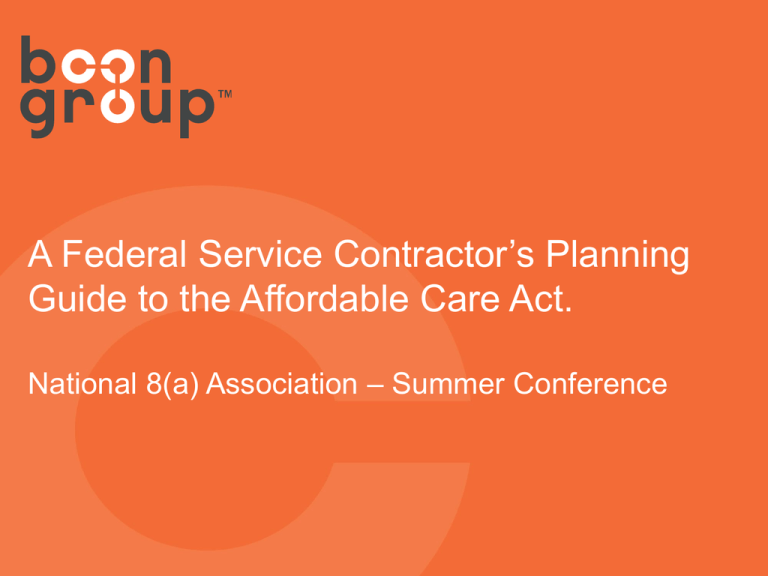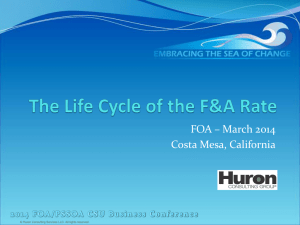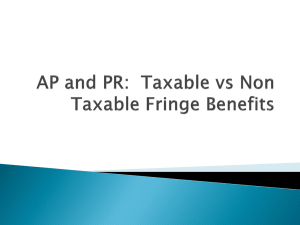A Federal Service Contractors Planning Guide to the Affordable
advertisement

A Federal Service Contractor’s Planning Guide to the Affordable Care Act. National 8(a) Association – Summer Conference Planning for compliance and the impact of health care reform Starts with understanding the basics: • The McNamara-O’Hara Service Contract Act of 1965 (SCA) • The Patient Protection and Affordable Care Act (PPACA), commonly called the Affordable Care Act (ACA) or “Obamacare” What is special about an SCA covered government contractor from a benefit perspective? • In general Service Contractors have minimum hourly requirements for payment of wages and fringe benefits. • This hourly funding requirement for benefits is called a fringe rate. • Fringe rates are adjusted each year; the current fringe is $3.81. • Benefits are required to be tracked on an hourly basis. (Complications can arise from trying to fit the hourly requirement into a traditionally priced monthly benefit plan.) What must a contractor do to satisfy the fringe benefit obligation? • • • • • • Fringe benefits need to be provided separate from, and in addition to, specified wages They may be discharged by furnishing equivalent benefits or cash in lieu of benefits Wages paid in excess of the WD (Wage Determination) minimum wage requirement cannot offset fringe requirement Benefits must be “bona fide” The fringe allocation must be tracked and accounted for compliance The employer, not the employee, has the right to choose how fringe dollars are allocated Bona Fide Fringe Benefit Fringe benefits that meet the requirements of the SCA defined in 29 CFR Part 4 Section 171. Are all employees working for a government contractor subject to an hourly fringe? • Most hourly employees who are working on a government services related contract are subject to the Service Contract Act and are entitled to fringe benefits. • • • The FLSA (Fair Labor Standards Act) is the law which classifies employees as exempt or non-exempt. Examples of employees who may be exempt from an hourly benefit requirement include: Executive Administrative (managerial) Professional Computer Professional Exemption ($27.62 per hour or more) Trend indicates an expansion of SCA to cover previously exempt labor categories. Are SCA covered employees treated differently under the Affordable Care Act? The answer is “no.” However, planning to correctly capture and allocate fringe dollars to meet the ACA employer mandate requirements is different for non-exempt (SCA covered) than for exempt employees. • • Exempt employees are not entitled to fringe benefits Careful consideration should be taken to follow ACA laws in a traditional manner. Non-Exempt or SCA employees receive an hourly fringe benefit How a contractor allocates the health and welfare fringe rate will determine compliance with the ACA. With ACA, SCA covered contractors can look at two ends of the spectrum … • Minimally embrace the law • Do the minimum to comply with ACA and SCA guidelines. • Examples Establish a minimum essential coverage (MEC) or minimum value (MV) affordable employee benefit plan. • Retain as much of the fringe as possible to continue to pay some cash in lieu of benefits Divert underspent fringe to retirement. Fully embrace the law Provide the best health plan possible within the fringe rate Plan for cost containment and competitiveness Support initiatives to reduce rate increases, and promote wellness on their jobsites Understand the basic aspects of the Affordable Care Act (ACA) to design the best strategy. Questions for a Service Contractor: • Who is covered under ACA? • What benefits are required? • What does a contractor have to provide? * For more information refer to the document titled “Preparing for the Affordable Care Act, A Service Contractors Checklist and FAQ’s” Who is covered under ACA? Full-time employees • • • Full-time employees only (simplified) Full-time employees are deemed by the ACA to average at least 30 hours of service per week. Standard look-back periods are one way to determine full-time status. For guidance and purposes of determining shared responsibility for employers under the Affordable Care Act, refer to final regulations on the Employer Shared Responsibility provisions. http://www.gpo.gov/fdsys/pkg/FR2014-02-12/pdf/2014-03082.pdf 2015 Transition Relief can be found at: www.irs.gov/uac/Newsroom/Questions-and-Answers-on-Employer-SharedResponsibility-Provisions-Under-the-Affordable-Care-Act What benefits are required? Offer at least Minimum Essential Coverage (MEC) / Minimum Value (MV) health plans • • • • • • ACA applies to health insurance and self-funded health plans, not to other benefit plans MEC and MV are baselines for coverage required under the Affordable Care Act Most limited medical, mini-med, and fixed indemnity plans sold in the past will need to migrate to compliant programs by the first of the 2014 plan year It is recommended that contractors seek out the expertise of brokers or carriers to determine if their current plans will meet minimum requirements Make sure to ask your benefit provider if your plan is compliant with current ACA guidelines A common modification to existing plans is a reduction of out-of-pocket maximums What must a contractor provide? Employer Mandate to provide affordable coverage • In order to use fringe benefit dollars to satisfy the Employer mandate to provide affordable coverage to its full-time population: A contractor should remove “cash as an option” By providing an employee with the choice of cash in lieu or health benefits, employee receives constructive receipt of fringe dollars. When an employee has constructive receipt of how to use fringe dollars The fringe is considered employee money The benefit election becomes “payroll deduction” This process doesn't satisfy the employer mandate Fringe is only considered employer dollars when the plan is employer paid. What must a contractor provide? Employer Mandate (continued) • To structure a compliant plan using fringe dollars • Employees should be required to participate (in the employer health plan) unless they have a valid waiver Or, the contractor could offer a defined contribution style plan, where an employee can choose between a selection of benefits. (However, here cash is not an option) A contractor can offer cash in lieu of benefits under limited circumstances. Underspent fringe, or cash in lieu of benefits would still be permissible as long as the employee was required to participate, and subsequently showed proof of other coverage in order to waive coverage under the contractor’s health plan. (not recommended) Challenges facing SCA contractors with the onset of the Affordable Care Act. • How to satisfy ACA requirements? • How to plan for and minimize exposure to rising health insurance costs? • How to remain competitive in a market of Low Price Technically Acceptable – LPTA contracts? Benefits Costs Compliance How to satisfy ACA requirements? Suggested best practices (Cost reduction ideas such as worksite wellness program and telemedicine service) • Review ACA requirements thoroughly with a broker, lawyer, or carrier representative • Try to cover 100% of the premium cost of employee level health coverage using fringe dollars • Consider offering ancillary benefits (dental, life, disability, vision) on an employee paid voluntary basis. • Remember that benefits are owed to all employees working an average of at least 30 hours per week. • Try to structure a benefit plan that can accommodate premium increases. How to plan for and minimize exposure to rising health insurance costs? • Fringe increases have averaged 3.43% over the last 7 years. • Increases for Health Insurance for Single Coverage has averaged 5.11%* • Tough decisions will need to be made on how to control escalating health costs which exceed year over year fringe increases. * SOURCE: Kaiser/HRET Survey of Employer-Sponsored Health Benefits, 1999-2012 * 2007-2012 Data SOURCE: Kaiser/HRET Survey of Employer-Sponsored Health Benefits, 1999-2012 How to plan for and minimize exposure to rising health insurance costs? (continued) Remove adverse selection from the benefit plan. • Adverse selection occurs when employees with existing health conditions or accelerated age choose coverage to address those factors but the healthier and younger employees do not choose to participate in plan, resulting in high claims’ costs without adequate premiums or contributions to offset those costs. • Adverse selection can be the most devastating aspect to a government contractor’s plan. • Contrary to the private sector where employees choose payroll deductions as a means to purchase benefits, contractors must pay the health and welfare fringe amounts in addition to base cash wages. • Paying the fringe in cash or allowing an employee to waive health coverage can cause a spiral of adverse selection, which leads to escalating costs. How to plan for and minimize exposure to rising health insurance costs? (continued) Remove adverse selection from the benefit plan. • To remove some adverse selection effects: Check and verify all employee waivers to your health benefit program. Only accept waivers based on proof of existing group coverage and recommend signed waiver forms with group policy number. • To remove all adverse selection Require all full–time SCA covered employees to participate in the health plan (Allowable: 29 CFR Part 4) This includes TRICARE members How to remain competitive in a market of Low Price Technically Acceptable – LPTA contracts? Think long term! • Health insurance costs rising faster than the fringe increases suggest that making tough decisions today may pay dividends in the future. • Remember under SCA guidelines contractors cannot force an employee to pay for fringe benefits from their wages. • Therefore, if a contractor requires an employee to participate in its benefit plan, costs have to be contained within the fringe or become a liability to the contractor. • Without a proper strategy, hemorrhaging health plan related costs could reduce profits on a 3, 5 or 7 year contract. How to remain competitive in a market of Low Price Technically Acceptable – LPTA contracts? (continued) Remain competitive by … Eliminating all remaining cash payments in lieu of benefits By paying cash in lieu of benefits, contractors take on additional payroll tax burden Consider retirement, supplemental health, or ancillary only plans for part-time employees •Reducing or eliminating contributions toward dependent coverage. •Reducing or eliminating any sick leave or excess vacation provided above what is required by the contract. How to remain competitive in a market of Low Price Technically Acceptable – LPTA contracts? (continued) Remain competitive by … •Taking steps today to make sure to correctly classify employees into distinct classes of full and part-time employees for planning purposes. •If employees vary in hours worked, it may be beneficial to choose a lower priced health option to ensure costs are contained to the fringe available each month. •Spend no more than the fringe available. Questions? Contact The Boon Group, Inc. 866 831 0847 www.boongroup.com Taylor Boon tboon@boongroup.com









